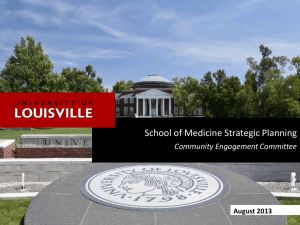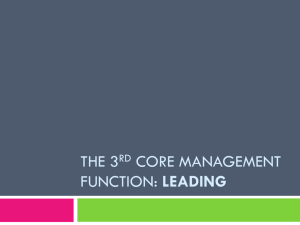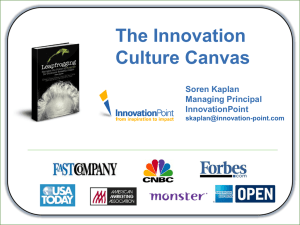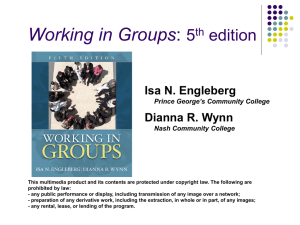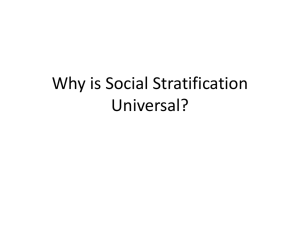IL SHRM 2012 Conference
advertisement
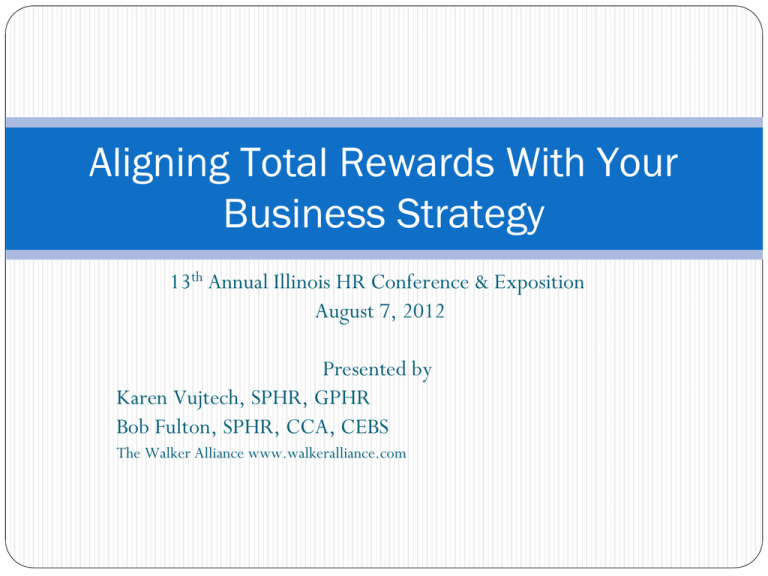
Aligning Total Rewards With Your Business Strategy 13th Annual Illinois HR Conference & Exposition August 7, 2012 Presented by Karen Vujtech, SPHR, GPHR Bob Fulton, SPHR, CCA, CEBS The Walker Alliance www.walkeralliance.com Defining Total Rewards Beyond just the financials to include all aspects of the work environment Intrinsic part of the organization's strategic direction 2 Compensation (direct, cash) Development Opportunities Benefits (indirect) Personal Growth Location Work Variety Flexibility Work Importance Social Interaction Authority/Control/Autonomy Status/Recognition Work Load Advancement Work Conditions August 7, 2012 Today’s Agenda Building a Strategically Aligned Total Rewards Strategy Assess: business strategy and current programs and policies Develop: Total Rewards philosophy; design or redesign programs/polices Execute: implementation and communication Evaluate: measure outcomes; interpret findings 3 August 7, 2012 Assess: Business Strategy Vision –what we seek to become Mission – why we exist Values - what is important to the organization in terms of behavior and culture Philosophy – guiding principles Strategy – the long-term ways through which we will achieve our mission/vision Operational plans – the way we bring the strategies alive for the organization 4 August 7, 2012 Assess: Tools and Process Know/understand your business’s strategic plan Conduct a SWOT Analysis of current Total Rewards offerings vs. business strategy, long and short-term goals and objectives Identify gaps between business strategy and total rewards practices, programs and policies (gap analysis) Use Framework of Foundation and Performance awards to assist analyses 5 August 7, 2012 Assess: Framework of Foundation and Performance Awards 6 August 7, 2012 Assess: Key Questions Which of the practices/programs are currently used? Which ones are most important to the overall organization in achieving business strategy and remaining competitive? Which are the most/least effective in supporting the mission, strategy and culture? Which programs/practices are important to specific employee groups, i.e., executives, sales, technical professionals, service, operational, etc.; new hires; high potentials? 7 August 7, 2012 Assess: Key Questions (continued) Where does the company spend the most money? Where does the company spend most time and effort? Does the application of some programs overlap or interfere with others? Are there any common themes that should exist across all programs? 8 August 7, 2012 Using a Balanced Scorecard as Planning/Evaluation Tool 9 August 7, 2012 Total Rewards Strategy Alignment: The Business Case Summarize all of the information/data received Include statistics on usage, cost, perceived value ( management and employees) Identify how/if/where existing programs and practices add value and support business strategy Propose the new Total Rewards Strategy alignment 10 August 7, 2012 Total Rewards Strategy Alignment: The Business Case Analyze and define gaps between existing programs and proposed new TR strategy Make recommendation(s) for: Next steps (design, redesign, elimination) Prioritization Timing Cost Propose new Total Rewards Philosophy Statement Obtain approval to move forward 11 August 7, 2012 Develop: Total Rewards Philosophy Statement Create a statement of your guiding principles for determining and delivering total rewards in your organization: A reward strategy should articulate in simple but powerful terms how the company will invest its resources, reinforce its core principles and values, and create a competitive advantage. Provides a framework for aligning rewards with business objectives 12 August 7, 2012 Sample Total Rewards Philosophy Statement 13 To achieve our company's mission and vision, we must attract, motivate and develop highly qualified and dedicated employees. Our Company provides competitive rewards to its employees with flexibility to address diverse and changing business and employment environments. This philosophy Applies to all employees Includes cash and non-cash rewards, benefits, recognition and development Is market competitive Stresses open communication and education August 7, 2012 Design/Redesign: Project Team Process Review all TR practices/programs for fit and impact on business strategy Identify which programs should: Be retained Be retained with changes Be recommended for elimination Based on feedback from Top Management, set Priorities Develop business case for the recommendations; Consider how changes will affect: Employee growth/development Ability to attract and retain employees Cost structure/preliminary ROI for recommended changes 14 August 7, 2012 Design/Redesign: Project Team Process Establish Team of Key Stakeholders for Oversight Team: Owners and Champions Responsible for managing the Big Picture Create Project teams to address TR component areas: Compensation Benefits Growth and Development Recognition and Work Environment 15 August 7, 2012 Design/Redesign: TR Area Project Teams Proposed design/design changes Assure alignment with overall TR strategy Test with focus groups, include HR Propose evaluation measures and metrics Create a business case and ROI for all recommendations 16 August 7, 2012 Execution: Implementing Strategy Determine necessary resources and timelines for implementation Assess and address implementation and plan rollout considerations Recalibrate with management, and with impacted groups Create a defined communication plan 17 August 7, 2012 Execution: Determine Resources What is required to implement and support each program area: Financial, personnel, systems Consider financial constraints and business limitations Will you use the same design team or a separate team of implementers? How can we build on prior successful implementations? 18 August 7, 2012 Execution: Implementation Issues Critical questions for implementation: Which SBUs, groups, functions, or departments are affected? What systems modifications or installations are required to move forward? What specific data tracking and reporting needs will each program area require? What type of ongoing administrative support is necessary? 19 August 7, 2012 Execution: Feasibility Analysis Some rewards components may require a more in-depth evaluation and/or trial period before full implementation What is the business ready for? What needs to be tested and tried? How can implementation be best achieved without significant disruptions? Think about this in the same way as many IT implementations – parallel systems, staging 20 August 7, 2012 Feasibility Analysis: Example Example: large food manufacturing company was considering implementing gainsharing as part of overall rewards strategy Met with senior leadership to explain the foundational aspects of this type of program Prepared a feasibility analysis examining relevant company issues 21 August 7, 2012 Feasibility Analysis: Example Before making the decision, we helped them to examine a number of critical factors, including: Culture: Cost/quality/safety/service philosophy is firmly rooted in the company’s method of work Demographic: Minimal issues with employee complaints, and with current pay levels Performance: Effective systems in place to measure performance Communication: Willing to share business information (operational, financial) with employees 22 August 7, 2012 Execution: Communication Plan Questions to consider in communicating strategy: What are the critical messages? What are the typical channels of communication? Which formats are employees used to? Who do employees trust to convey these messages? How can you create support and buy-in with key business leaders, natural champions, and skeptics? How do you drive active rather than passive communications? 23 August 7, 2012 Evaluation: Business Value Defining & measuring outcomes, metrics and ROI Strategic HR considerations: how does the TR strategy address Employee engagement or satisfaction? Recruitment & retention? Performance effectiveness? 24 August 7, 2012 Evaluation: Metrics Metrics can be developed to measure the effectiveness of your TR strategy by linking expected outcomes with actual results Every component of the TR strategy should have some sort of measured ROI This is normally addressed in the Execution phase Work with your CFO and with HR staff to define 25 August 7, 2012 Using a Balanced Scorecard as Planning/Evaluation Tool 26 August 7, 2012 Evaluation: Metrics Total Rewards strategy metrics can include: Number of employees who have access to career/TR/work online administration site Decreased turnover or increased candidate acceptance of offers Significant difference in pay relative to performance Increased participation is specific work/life or retirement programs Lower benefit costs from selective usage by those who need a particular benefit program 27 August 7, 2012 Example: Pay for Performance If your company has a pay for performance philosophy, this can be the place to start the evaluation process For most companies, pay for performance is a throw-away phrase that keeps leadership thinking that the TR program working effectively How is it working for your company? How do you know? 28 August 7, 2012 Final Thoughts Aligning all Total Rewards components with business strategy can improve business results and customer satisfaction while improving employee engagement and satisfaction. Total Rewards is more than just compensation and benefits 29 Compensation (direct, cash) Development Opportunities Benefits (indirect) Personal Growth Location Work Variety Flexibility Work Importance Social Interaction Authority/Control/Autonomy Status/Recognition Work Load Advancement Work Conditions August 7, 2012 Final Thoughts Follow all the Steps: Assess: business strategy and current programs and policies Develop: Total Rewards philosophy; design or redesign programs/polices Execute: implementation and communication Evaluate: measure outcomes; interpret findings 30 August 7, 2012 Final Thoughts You’re not finished! Periodically review TR components for alignment Every 3 years to make sure still aligned with business strategy After merger, acquisition, restructuring Due to regulatory or legal changes 31 August 7, 2012 32 August 7, 2012 Karen Vujtech, SPHR, GPHR Total Rewards Consulting, Inc. kvujtech@totalrewardsconsulting.com Robert Fulton, SPHR, CCP, CEBS The Pathfinders Group, Inc. rfulton@pathfindersgroupinc.com www.walkeralliance.com August 7, 2012 33


